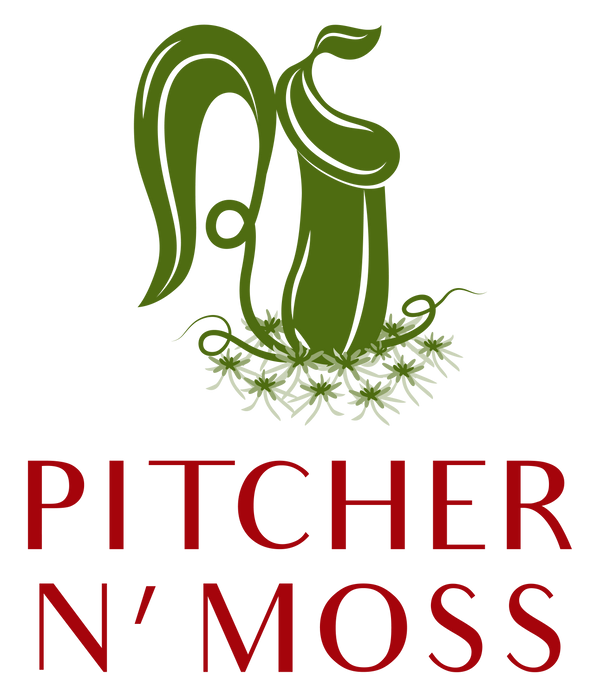A Beginner's Guide to Growing Nepenthes
There are so many nepenthes species out there and different species grow in different conditions. Some may be more tolerant while some others may be specific. Yet it is almost impossible to simply summarise one growing guide for all, there are still some helpful general tips can be used as a guide for nepenthes cares. We suggest growers to combine those general knowledge with their own experience and experiments to find out the best conditions for their plants. When growing highly collectable or rare plants, it is a good idea to search for the specific information about the particular plants you have.
Light
Nepenthes generally like bright indirect light. They may be able to handle direct light in mornings or during cool climate. Many nepenthes leaves can turn reddish when they receive plenty of light. Light is one of the very important factors that impact the pitcher development. when nepenthes receive plenty of light, they can develop larger and more colourful pitchers, while not enough light can result bigger and greener leaves with smaller pitchers, or in some cases, no pitchers. That said, too much light (such as full sun) can result sun-burn on the leaves.
Water
Nepenthes are generally more tolerant to dissolved salts and minerals in water than other carnivorous plants. However, it does not mean that they do not need high quality water. Rain water, RO water ( Reverse Osmosis system), distilled water are some of the best options, depending on where you live, tap water may be fine.
Nepenthes like potting media to be moist, never allow the media to completely dry out, nor allow nepenthes to constantly sit in water, which will cause root rot. Watering should be done carefully in winter months when the plant growth is slow and media stay wet for longer after watering. Water when the potting media is slightly dry.
Potting Media
There are plenty of options for you when it comes to potting media for nepenthes. The key features for nepenthes potting media include good water holding capability, good drainage, no fertiliser or rich nutrient. Never use potting mix or garden soil as they will kill your nepenthes. Our favourite potting media for nepenthes is 50/50 sphagnum moss and perlite. There are also other great ingredients can be added, such as coconut coir, peat moss, orchid bark, horticultural sand, etc.
temperature
Nepenthes can be generally classified as three types: highland, lowland and intermediate, each of them thrive in different temperature range.
Highland
Highland nepenthes in the wild grow in the high attitude zones in the mountains, where there have warm day temperatures and cool night temperatures, and significant night time temperature drop. In general, the day temperature is between 22-25°C, night time temperature between 10-15°C. Around 10-15 degree night time temperature drop is important and beneficial.
Lowland
Lowland nepenthes in the wild grow in the low attitude zones, where constantly has warm to hot temperature, therefore, they do not like cold climate. Usually the suitable temperature range for lowland nepenthes is day temperature 28-32°C and night temperature 20-25°C.
Intermediate
Intermediate nepenthes grow in the temperature range between highland range and lowland range. They are lesser particular than either highlanders or lowlanders, and usually able to tolerate wide range of temperature and conditions. Most hybrids are considered as intermediate. Most intermediate nepenthes can grow in the temperature range between 15-30 Celsius, many can even tolerant higher or lower temperatures.
Humidity
Humidity is not the key to nepenthes survival as long as the potting media is kept moist. However, they do prefer high humidity environment than lower. Low humidity is one of the main reasons nepenthes do not produce pitchers. In general, nepenthes do well in 70-80% humidity. However, high humidity also favours disease development, especially in greenhouse, grow tent or other enclosed environments. Good ventilation and air movement are important, as well as good cultural practice and good hygiene. Regular and correct use of preventative fungicide mmay alao help with disease prevention. We also find most nepenthes grow well with day humidity around 60% with naturally increased night humidity around 85-90%.
Pathogens such as fungi, bacteria and virus are everywhere in the environment and it is impossible to eliminate them, but most of them are only able to cause diseases when condition favours. Therefore, prevention should always be the priority.
Nutrients
As we know, nepenthes is one of the most iconic carnivorous plants, in their naturally habitats they intake nitrogen by trapping and digesting insects or small animals. If your nepenthes are growing at the location where they can catch insects themselves, fertilisation is not needed.
If catching preys is not an option, there are a few ways to fertilise nepenthes. Please note, no matter what method you use, always start from very diluted dose, observe how they response and gradually increase the dose if needed. We use Powerfeed All purpose for our nepenthes.
Pitcher feeding: pitcher feeding is the best and safest feeding option in our opinion. The only downside is that it may not be practical if you have large number of plants. You can either feed pitchers with small insects or diluted fertiliser.
Foliar feeding: spray the diluted fertiliser onto leave evenly.
Root feeding: root feeding is also an option when it is done carefully. However, t is not recommended for beginners.
